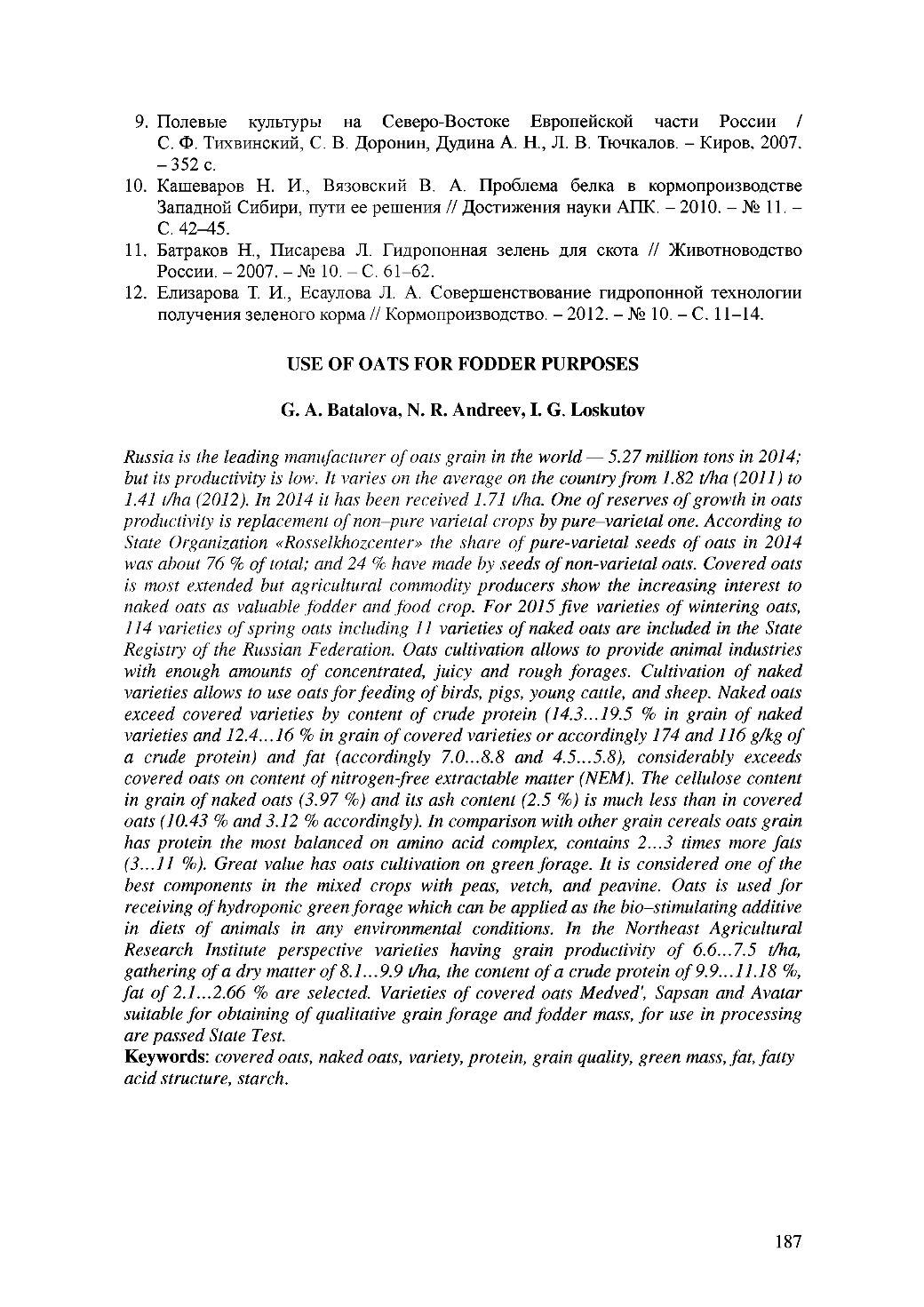

9. Полевые культуры на Северо-Востоке Европейской части России /
С. Ф. Тихвинский, С. В. Доронин, Дудина А. Н., Л. В. Тючкалов. - Киров, 2007.
- 3 5 2 с.
10. Кашеваров Н. И., Вязовский В. А. Проблема белка в кормопроизводстве
Западной Сибири, пути ее решения // Достижения науки АПК. - 2010. - № 11. -
С. 42-45.
11. Батраков Н., Писарева Л. Гидропонная зелень для скота // Животноводство
России. - 2007. - № 10. - С. 61-62.
12. Елизарова Т. И., Есаулова Л. А. Совершенствование гидропонной технологии
получения зеленого корма // Кормопроизводство. - 2012. - № 10. - С. 11-14.
USE OF OATS FOR FODDER PURPOSES
G. A. Batalova, N. R. Andreev, I. G. Loskutov
Russia is the leading manufacturer o f oats grain in the world
—
5.27
million tons in 2014;
but its productivity is low. It varies on the average on the country from 1.82 t/ha (2011) to
1.41 t/ha (2012). In 2014 it has been received 1.71 t/ha. One o f reserves o f growth in oats
productivity is replacement ofnon-pure varietal crops by pure-varietal one. According to
State Organization «Rosselkhozcenter» the share o f pure-varietal seeds o f oats in 2014
was about 76 % o f total; and 24 % have made by seeds o f non-varietal oats. Covered oats
is most extended but agricultural commodity producers show the increasing interest to
naked oats as valuable fodder and food crop. For 2015 five varieties o f wintering oats,
114 varieties o f spring oats including 11 varieties o f naked oats are included in the State
Registry of the Russian Federation. Oats cultivation allows to provide animal industries
with enough amounts o f concentrated, juicy and rough forages. Cultivation o f naked
varieties allows to use oats for feeding o f birds, pigs, young cattle, and sheep. Naked oats
exceed covered varieties by content o f crude protein (14.3...19.5 % in grain o f naked
varieties and 12.4... 16 % in grain o f covered varieties or accordingly 174 and 116 g/kg o f
a crude protein) and fa t (accordingly 7.0...8.8 and 4.5...5.8), considerably exceeds
covered oats on content o f nitrogen-free extractable matter (NEM). The cellulose content
in grain o f naked oats (3.97 %) and its ash content (2.5 %) is much less than in covered
oats (10.43 % and 3.12 % accordingly). In comparison with other grain cereals oats grain
has protein the most balanced on amino acid complex, contains 2...3 times more fats
(3...11 %). Great value has oats cultivation on green forage. It is considered one o f the
best components in the mixed crops with peas, vetch, and peavine. Oats is used for
receiving o f hydroponic green forage which can be applied as the bio-stimulating additive
in diets o f animals in any environmental conditions. In the Northeast Agricultural
Research Institute perspective varieties having grain productivity o f 6.6...7.5 t/ha,
gathering o f a dry matter o f 8.1... 9.9 t/ha, the content o f a crude protein o f 9.9.. .11.18 %,
fa t o f 2.1...2.66 % are selected. Varieties o f covered oats Medved', Sapsan and Avatar
suitable fo r obtaining o f qualitative grain forage and fodder mass, for use in processing
are passed State Test.
Keywords:
covered oats, naked oats, variety, protein, grain quality, green mass, fat, fatty
acid structure, starch.
187
Электронная Научная СельскоХозяйственная Библиотека









